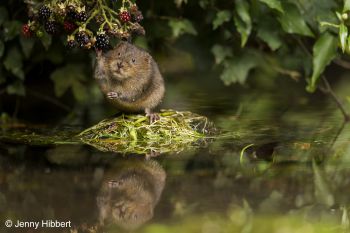
© Jenny Hibbert
A third of native mammals are currently at risk of extinction in Wales, according to a new report.
The State of Mammals in Wales report examines for the first time in over 20 years the current situation for species in the country.
Launched this week by the Mammal Society, it estimates that hedgehog populations have declined by 60% since the last population estimates made in 1995. Water voles continue to be the fastest declining species and are now classed as endangered, meaning that without further action they are likely to go extinct in Wales within our lifetimes.
Fiona Mathews, Professor of Environmental Biology at the University of Sussex, is Chair of the Mammal Society. She stressed the need to do much more to sustain and create connected habitats across the country, giving mammals the ability to move easily from one area to another.
Prof Mathews said: "As well as allowing other crucial ecological processes, the creation of such corridors will aid the exchange of genes that will ensure a healthy future for species such as harvest mice and water voles. If we do not take action now to reverse the fortunes for these creatures I fear it will be too late."
Commissioned by Natural Resources Wales, the report provides a species-by-species account of current population sizes and range trends, as well as discussing threats and conservation opportunities.
Sam Dyer, NRW Specialist Advisor for Terrestrial Mammals said, "This is a very comprehensive report which examines the current situation for Wales' 49 terrestrial mammal species, and we are grateful to all those who contributed to the resulting publication.
"These findings are key to our mammal conservation efforts and will underpin our decision making and targeting efforts towards those species who are at a greater risk."
The State of Mammals in Wales report also details successes in mammal conservation. Current efforts to reinforce pine marten populations have been extremely successful and the country remained a stronghold for polecats when they all but disappeared from the rest of the UK. Wales also holds three focal sites for red squirrels.
There are also significant populations of greater and lesser horseshoe bats as well as colonies of rare species such as Bechstein's and barbastelle bats.
Mammal Society Science Officer, Dr Frazer Coomber, also based at the University of Sussex, explained that there are steps that the public can take to help mammals in Wales.
He said: "Information is key in shaping the current situation on Wales' mammals. That is why we have created the Mammal Mapper app that allows you to record what is out there and report sightings such as tracks and droppings whilst on your daily walk or on a family day out.
"This data will be crucial in enabling us to assess and review our conservation efforts, allowing future generations to enjoy these special mammals for years to come."
It is hoped that the production of this report will steer mammal conservation efforts in Wales, identifying priorities and the action needed to address the main issues and highlight future research requirements. This information has also been used to complete an International Union for Conservation of Nature (IUCN) Red Listing assessment.
The findings follow on from the release of the first official Red List for British Mammals back in July 2020, which revealed that one quarter of native mammals in Britain were at risk of extinction.
The State of Mammals in Wales report is available to download from the Mammal society website, www.mammal.org.uk.






